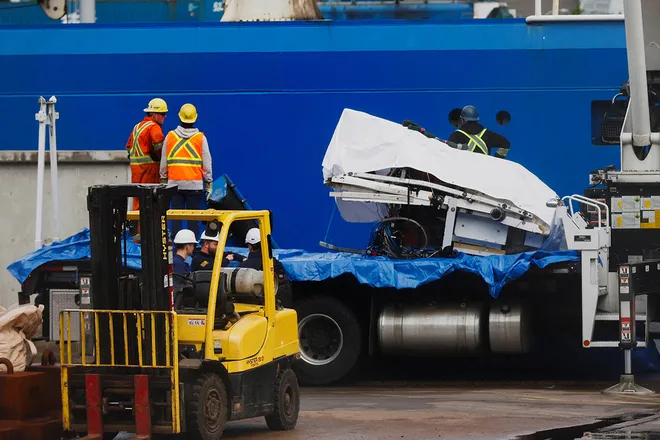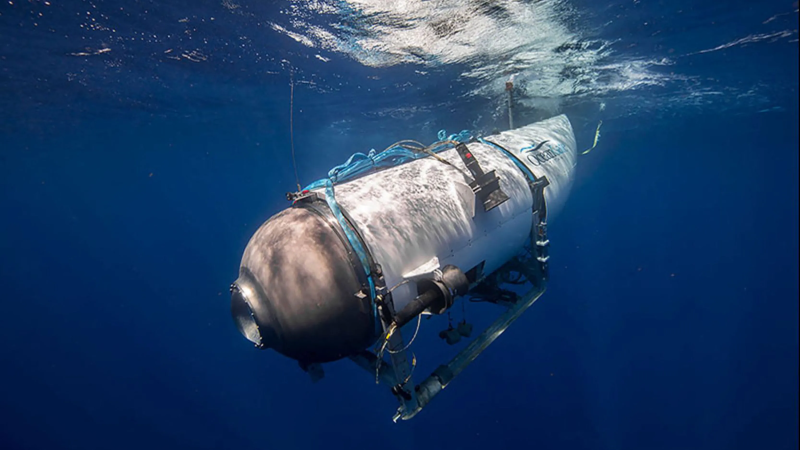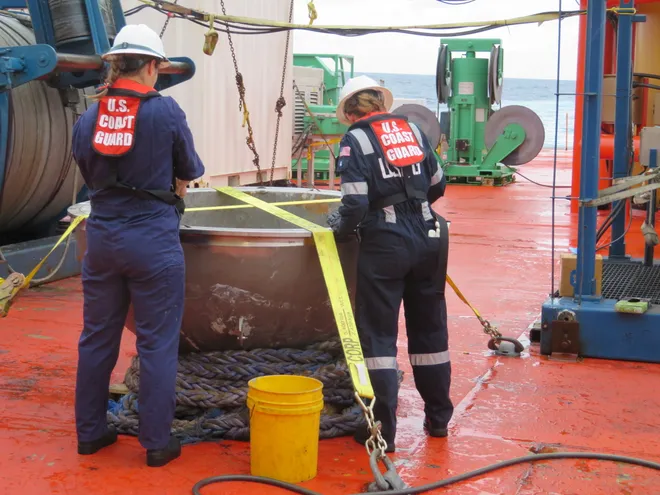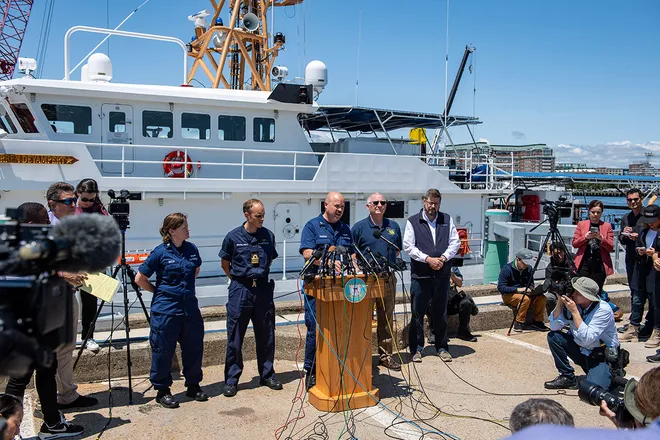Catastrophic Titan sub disaster: A year later the search for answers continues.
A year after a tiny submersible imploded, crushing all aboard on their way to see the famed wreck of the Titanic, little has changed.
No official reports have been issued detailing what happened to the Titan sub, how it happened, who was responsible and how such a massive implosion could have been prevented.
The families of those who died are still mourning. Hussain Dawood wrote Tuesday about the loss of his son and grandson in the tragedy: “We will continue to remember them and celebrate the myriad ways in which they have enriched our lives. We wish to spend this time together in private to remember them as they were; two inseparable explorers who were curious about the world and reveled in its boundless beauty,” he said.
The U.S. Coast Guard says its investigation is taking "longer than initially projected," in part because of two salvage missions needed to secure critical evidence and extensive forensic testing. The agency hopes by the end of the year to hold a hearing, providing answers to the public and devastated family members, such as Christine Dawood, who lost her son and husband.
The Coast Guard, in a statement, extended " its deepest condolences to the families and friends of the five individuals who lost their lives."
“The investigation into the implosion of the Titan submersible is a complex and ongoing effort,” said Jason Neubauer, Coast Guard chair for the Titan Marine Board of Investigation. “The MBI is committed to ensuring that we fully understand the factors that led to this tragedy in order to prevent similar occurrences in the future."

In the meantime, another adventurer has announced plans to take passengers to the Titanic in a submersible.
The implosion on June 18, 2023, occurred just hours into a dive carrying four passengers on what was to have been the trip of a lifetime 12,500 feet deep to the Titanic's final resting place. The ship sank in 1912 on its maiden voyage from England after hitting an iceberg. More than 1,500 people died. The ill-fated trip was the subject of numerous books and films, including the 1997 movie "Titanic."
The Transportation Safety Board of Canada and the French Marine Casualty Investigation Authority are working with the Coast Guard and the National Transportation Safety Board to conduct "parallel safety investigations," according to the Coast Guard.
French authorities are involved because one of the dead was Titanic expert Paul Henri-Nargeolet, a French citizen. Canadian authorities are involved because the Titan submersible was transported to the dive site aboard the Canadian-flagged support vessel Polar Prince, which launched from Newfoundland, Canada.
The Canadian Transportation Safety Board told USA TODAY in an email it had no planned media briefings scheduled on the investigation. In an update posted Tuesday, the board said the Canadian investigation was in the "report stage." The head of investigations for Transport Canada said in an update last week that investigators had determined the Titan submersible made as many as 29 dives between July 2021 and June 2023 – 10 in Canadian waters and 19 elsewhere.
"During these operations, the Titan and its platform were not registered or certified in Canada or any other country," wrote Lija Bickis, head of Marine Investigations for Transportation Safety Board of Canada.
Bickis said investigators found other manned submersibles operating in Canadian waters before and after the Titan implosion that also weren't registered. "However, the investigation has been unable to confirm whether these submersibles have been subject to oversight by (Transport Canada) or other certifying bodies."
What happened to the Titan submersible?
The Titan's trip, expected to take two hours, began at 8 a.m. about 435 miles off the coast of Newfoundland.
An hour and 45 minutes later, the submersible's support ship lost contact with it. At 3 p.m., the Titan failed to surface. The frantic search and rescue operation that ensued transfixed the world for four days.
On board were Stockton Rush, CEO of OceanGate Inc., the company that built the vessel; Nargeolet, 73, a French deep-sea explorer; Hamish Harding, 58, a British pilot and adventurer; Shahzada Dawood, 48, a Pakistani-British businessman and his 19-year-old son, Suleman Dawood.
It was not until 11:48 a.m. June 22, that the U.S. Coast Guard announced the discovery of a debris field. The vessel likely suffered a "catastrophic implosion" and OceanGate announced all occupants of the Titan had been lost.

Dawood family still mourns
Christine Dawood had planned be be aboard the Titan that fateful day but let her son go with her husband instead. She told the BBC last summer she was coping but struggling.
On the anniversary of the deaths, her father-in-law Hussain Dawood, grandfather of Suleman and father of Shahzada, released a statement saying they were still trying to come to terms with the loss.
“A year on, we are still trying to come to terms with Suleman and Shahzada not being with us," he said. "They have left a vacuum which is hard to fill."
The family was especially grateful for the outpouring of love and empathy from around the world it received in the aftermath of the accident.
“We also wish to thank all those who have supported us during the early tumultuous days and throughout the year with their kindness and grace. Many candles have been lit, many prayers have been spoken and many embraces shared. Each gesture has given us the strength to survive the unimaginable.”
Who's been held accountable?
Two weeks after the incident, OceanGate said on its website it had suspended "all exploration and commercial operations." Its headquarters in Everett, Washington, were shuttered. Founded in 2008, its business license expired on June 7, according to Washington Department of Revenue records.
The nonprofit research wing of the company, called OceanGate Foundation, was launched in 2010 but also closed in 2023, according to Washington Department of Revenue records.
OceanGate Inc. also operated a subsidiary, OceanGate Expeditions, out of the same office. According to Washington records, it closed on March 31, 2021.
The Titan accident involved a non-U.S. flagged vessel and occurred in international waters, making oversight and regulation responsibilities a complex question, according to an analysis by the law firm of Holland & Knight.
“Since it occurred in international waters, in terms of jurisdiction it’s kind of fair game,” said Thomas Galligan, a law professor at Louisiana State University with expertise in maritime law. “Depending on the citizenship of the parties involved, it could be in several countries.”
That could include the United States, France, the United Kingdom and potentially Canada because the Polar Prince support vessel was Canadian-flagged.
After the Titan incident, the Coast Guard conducted a review of its guidance for passenger-carrying submersibles. The Navigation and Vessel Inspection Circular (NVIC) No. 5-93 on Guidance for Certification of Passenger Carrying Submersibles had not been updated since 1993. But Coast Guard officials concluded it doesn't need updating.
"Therefore, the Service has no intention to do so at this time," Melissa Leake, with the Coast Guard's Office of Public Affairs, told USA TODAY.

Did OceanGate follow U.S. submersible guidance?
Guidance is just that, guidance. OceanGate was not obliged to follow it, and chose not to by failing to certify or "class" its vessels with any international maritime groups.
The company conceded this point in a 2019 blog post. As the website is no longer operational, the post is no longer on its site but USA TODAY was able to retrieve it from an internet archive site.
“Most major marine operators require that chartered vessels are 'classed' by an independent group," the post said. "These groups have assembled very detailed standards for classing everything from oil tankers to auxiliary ship equipment like Remotely Operated Vehicles (ROVs). Many of these standards are based on industry practice or covered by regulations such as reserve buoyancy, the number of life rafts, the types of materials that can be used on a hull, etc.”
OceanGate specifically rejected being classed, saying its innovative design was “outside of an already accepted system.”
It also said it could not innovate and make quick changes if it had to deal with the “multi-year approval cycle due to a lack of pre-existing standards, especially, for example, in the case of many of OceanGate’s innovations, such as carbon fiber pressure vessels.”
Instead, OceanGate said it worked to the highest standards of safety and had created an innovative system it called “real-time (RTM) hull health monitoring.”
“With this RTM system, we can determine if the hull is compromised well before situations become life-threatening, and safely return to the surface.”
That did not happen June 18, 2023. It’s thought the Titan was crushed in a violent inward collapse when it reached a depth its hull, perhaps because of microfractures, could no longer withstand.
It is possible the crew was aware of a problem and was trying to return to the surface, but could not. Several engineering simulations suggest the actual implosion would have occurred so quickly the Titan’s occupants would have not known it was happening.

Can the families sue?
According to multiple new media reports, all passengers on the Titan signed extensive liability waivers before undertaking the voyage.
Whether these would hold up in court would first require the families to prove the company was negligent. The nation in which a lawsuit is filed matters.
In the United States, 46 USC 30509 invalidates such clauses in contracts for passage between U.S. ports or between a U.S. port and another place, said Martin Davies, a professor of maritime law at Tulane University Law School. "However, the 'voyage' here was intended to be to and from the support vessel, so I don't think the statute could possibly apply."
Even if OceanGate no longer has any money, passengers' families could sue its insurance company for wrongful death claims, said Davies.
"Many jurisdictions allow plaintiffs to sue an insurance company directly if the insured has gone bankrupt," he said.
If someone were to sue on behalf of the families of passengers, whatever court the lawsuit was filed in would do a “choice of law” analysis, said Galligan.
“They look at the flag of the vessel, the base of operations of the company that ran it and try to decide where the suit should be tried,” he said.
Asked which country, the U.S., U.K, France or Canada that could be, Galligan said, “It could be any or all of the above.”
Disclaimer: The copyright of this article belongs to the original author. Reposting this article is solely for the purpose of information dissemination and does not constitute any investment advice. If there is any infringement, please contact us immediately. We will make corrections or deletions as necessary. Thank you.




